News
Thailand Twin Centre: Part Two

After a two hour journey to the pier, we got a first glimpse of our boat – the MV Sawasdee Fasai – run by West Coast Divers. This was going to be our home for the next few nights and where we would enter the water from. What struck me straight away was the length of the boat. A long boat at 37m, it made for an extremely spacious dive deck onboard. Luckily we weren’t at maximum capacity onboard either. For the dive company this isn’t ideal but for us as divers it meant more space and less divers in the water. The boat has 15 cabins and can accommodate up to 30 guests. We came across most other liveaboards along our journey and I’d say our boat looked to be the biggest and most spacious in the area.
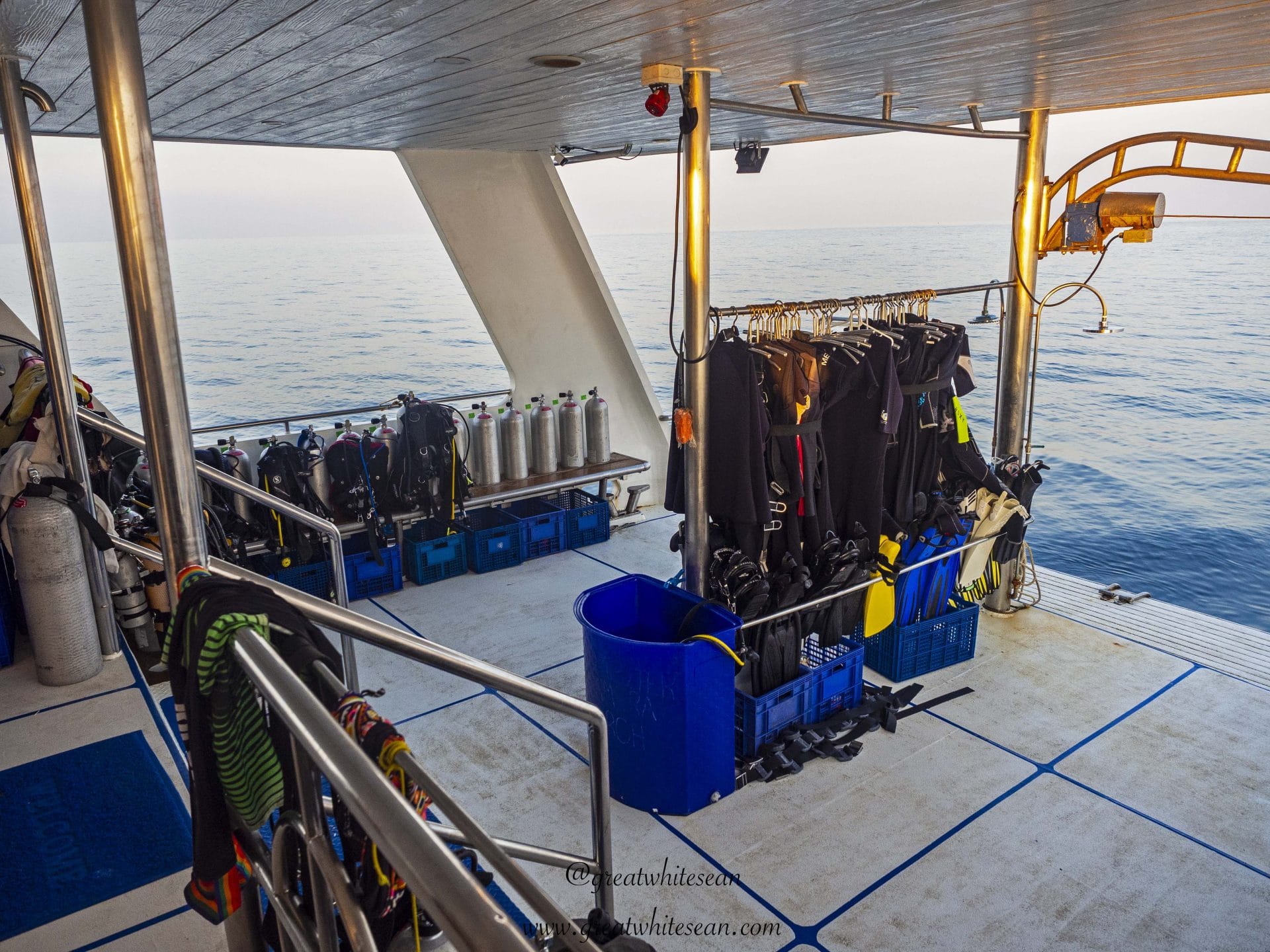
We set sail after a thorough briefing by the boat leader Beto and a delicious dinner prepared by the two chefs onboard. It was five hour sail during the night over relatively calm seas. We woke in the morning to stunning views over the turquoise sea that met with meticulously placed granite boulders at the island’s edge. The islands rose to a modest height but were densely covered in lush green rainforest with white-bellied sea eagles frequently seen patrolling each island. We had arrived at the stunning Similan Islands National Park for our first day of diving.
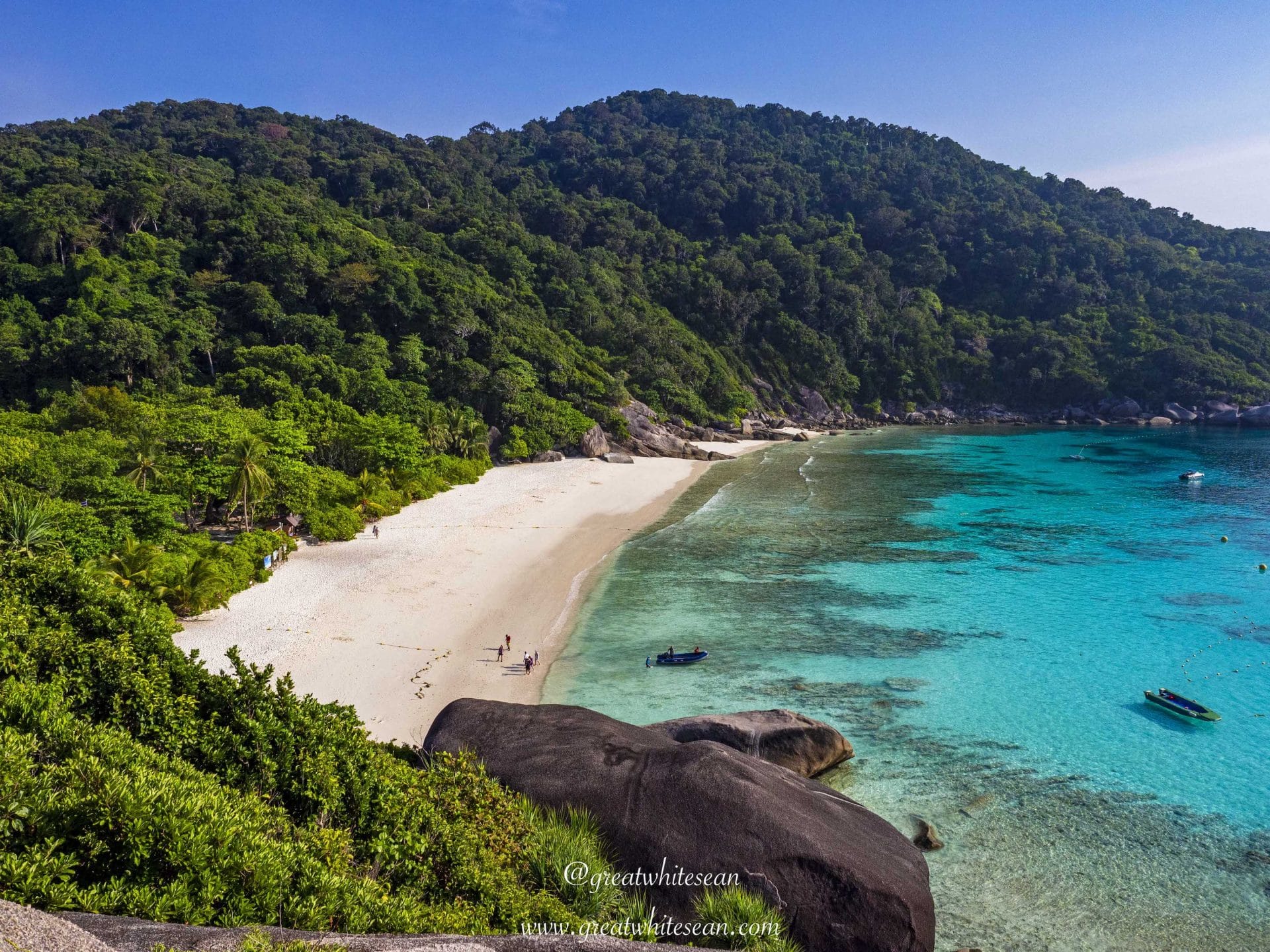
We were treated to much better visibility diving here compared to some of the sites around Phuket and Phi Phi. 25+ metres was the norm, although the odd thermocline rolling in made the dives more adventurous as they chased us through the water engulfing us in hazy water reducing the vis and the temperature drastically for a very short moment.
Again, scorpionfish were abundant during the dives here and for the first time in my diving life I also got to watch as one awkwardly bimbled along the sandy bottom. The soft coral here was just as stunning as the day diving but was more abundant as gorgonian fan corals dominated the boulders underwater creating interesting swim throughs, especially at the Elephant Head Rock site. The change of current through each turn was interesting to see but did make some of the dives more difficult on occasions. Air didn’t last as long on these dives but the adventure was cranked up a little to compensate.
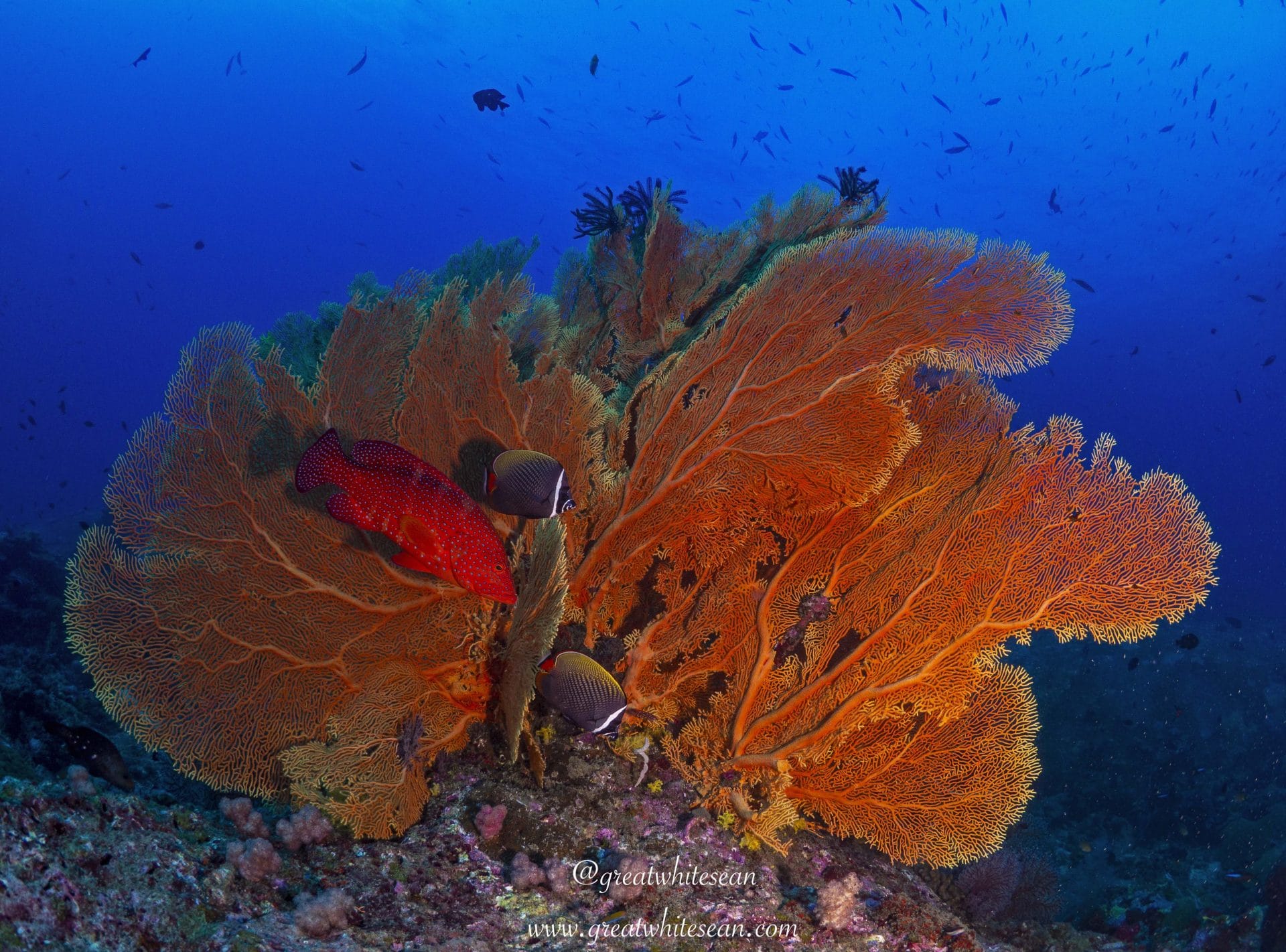
After dive three we moored up in Donald Duck Bay and had the opportunity to go on the island and marvel at the beautiful white sandy beach surrounded by lush rainforest. After a short but interesting hike up granite boulders in only flip flops to a view point, we were greeted with a view where I instantly knew why this had become a protected national park. The rainforest oozed with life as the soothing sounds of birds greeted our presence and if you listened carefully the ground would talk, as small lizards and insects worked their way through the foliage. One lizard even scuttled across our path.
The coral reef was easily visible through the clear turquoise water as the colour of the sea turned a deep blue the further you looked out. I certainly felt a sense of paradise standing there in awe of Nature’s beauty. Once we returned to the boat it was time for a night dive in the bay and my favourite dive of the day. I love a night dive and after saying I was going to find a pygmy squid, it gave me great joy to catch one in my light. A little guy only about a centimetre in size that I unfortunately lost before I could get my camera focused on it. Other critters were a little more willing to be photographed though and it was an enjoyable dive.
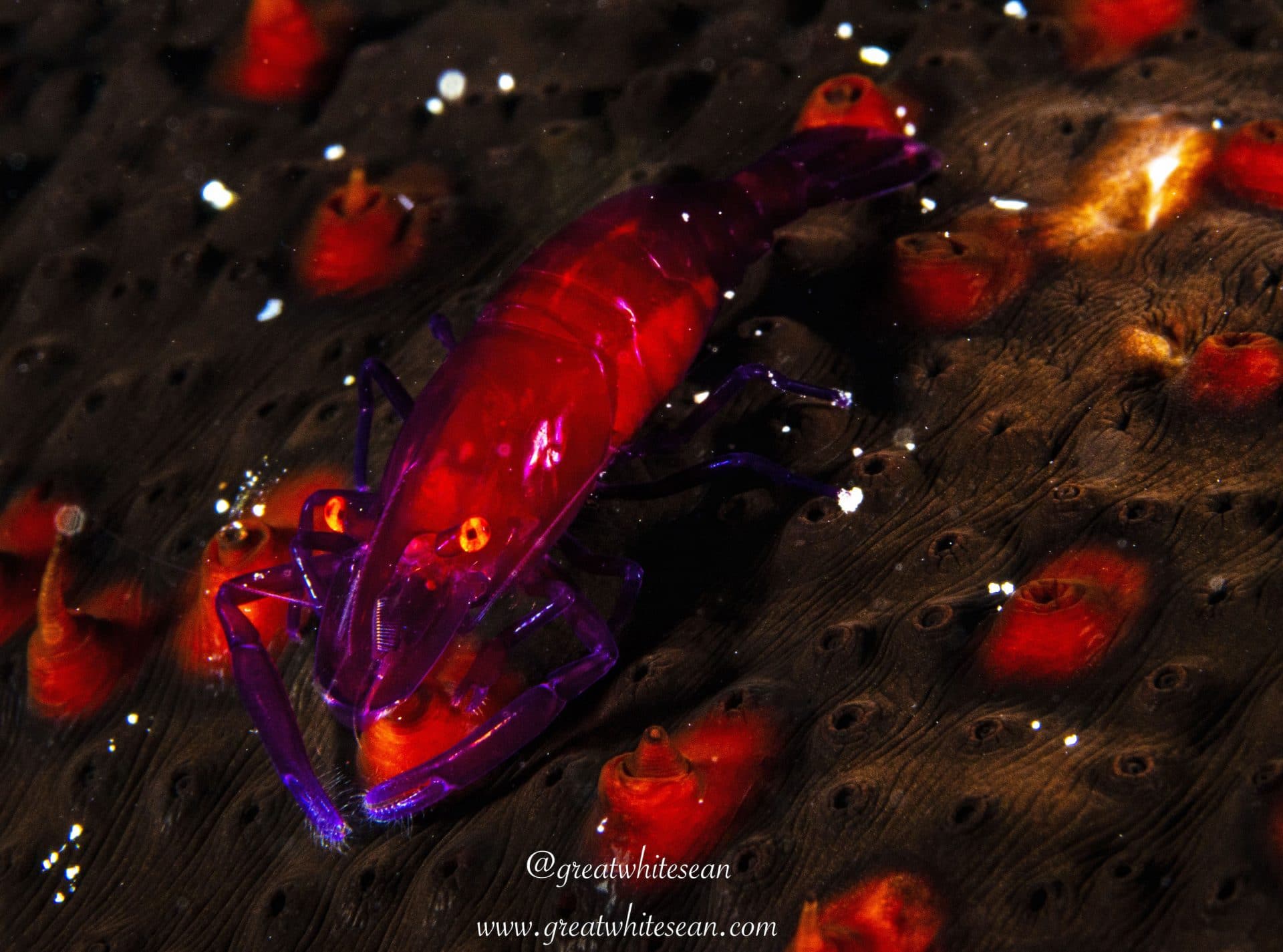
Day Two was the start of our journey north to the islands of Koh Bon and Koh Tachai. The topside view hadn’t changed but we were here as these two islands gave us the better opportunity to hopefully get lucky with some big sightings. Manta rays and whale sharks are the stars of these islands as long as you are lucky. Unfortunately, we were the unlucky ones and they both proved elusive this time. It left me a little despondent after dive three where a ripping current at Koh Tachai Pinnacle left us suspended like waving flags on a mooring line and unfortunately didn’t deliver the whale shark we were hoping to see.
We decided to risk the current at the Pinnacle once more for the sunset dive and luckily for us it had died down and let us explore a site full of life. This dive saved the day and I didn’t let the disappointment of a whale shark being elusive get me down. I could appreciate this stunning site of granite boulders covered in soft coral and full of life surrounding them. We had fish feeding on jellyfish and a titan triggerfish let me get close and photograph it as it gorged on its feast. Then at the surface we had a beautiful white-spotted jellyfish to photograph as the sun was setting.
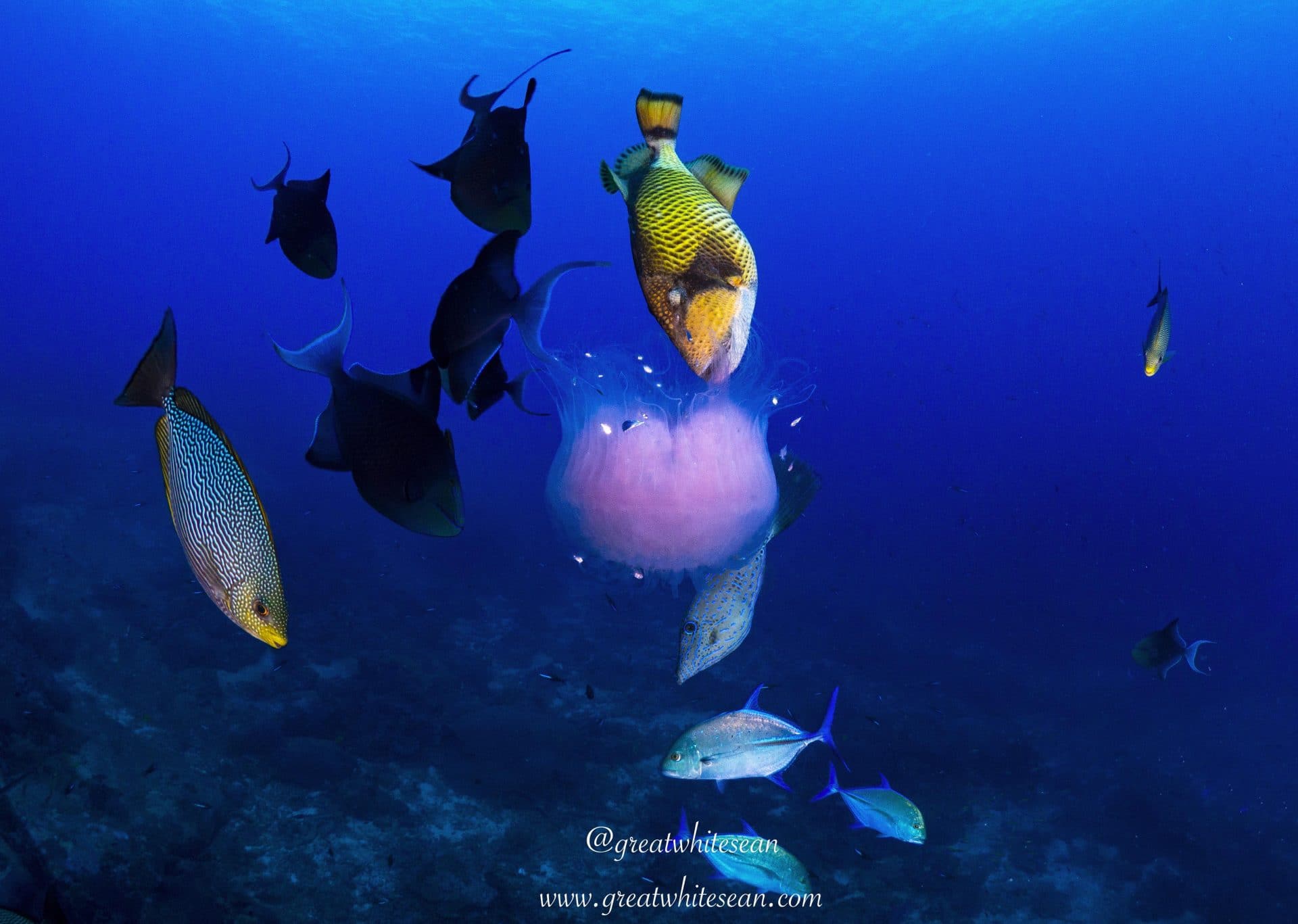
After a nice leisurely drift dive at the start of day three in Surin Island, it was time to head north again to the site I’d been eagerly anticipating since this trip was organised. Richelieu Rock was the destination and sure enough it didn’t disappoint as it was magnificently manic as soon as you dropped in. Schooling fish engulfed the site as small bait fish were hunted by bigger fish such as giant trevallies, big eye jacks, barracuda and more that would swarm round you as we drifted through the site. It was also the colours of the site that blew me away as soft coral dominated the pinnacles and anemones full of clownfish covered the top of the rocks like a carpet.
Richelieu Rock is also a great site for macro spotting but beware of the current as on some occasions it can be difficult for macro photography as you can’t take it slow exploring the reef. Then even if you do spot a macro wonder, it’s hard to stop and compose the shot without sucking the air out of your tank too quick. Luckily for me the last dive of my trip provided calmer currents and an opportunity to photograph a stunning ornate ghost pipefish, along with a peacock mantis shrimp, some nudibranch, dancing shrimp, and a white-eyed moray. Unfortunately I missed out on a harlequin shrimp that someone else on our boat spotted. A critter that still remains elusive for me. A good reason to do a few dives at this site and experience it all including a change in current. Another word of warning at this site is not to get too close and put your hand down. I’ve never saw so many scorpion fish in one place before.
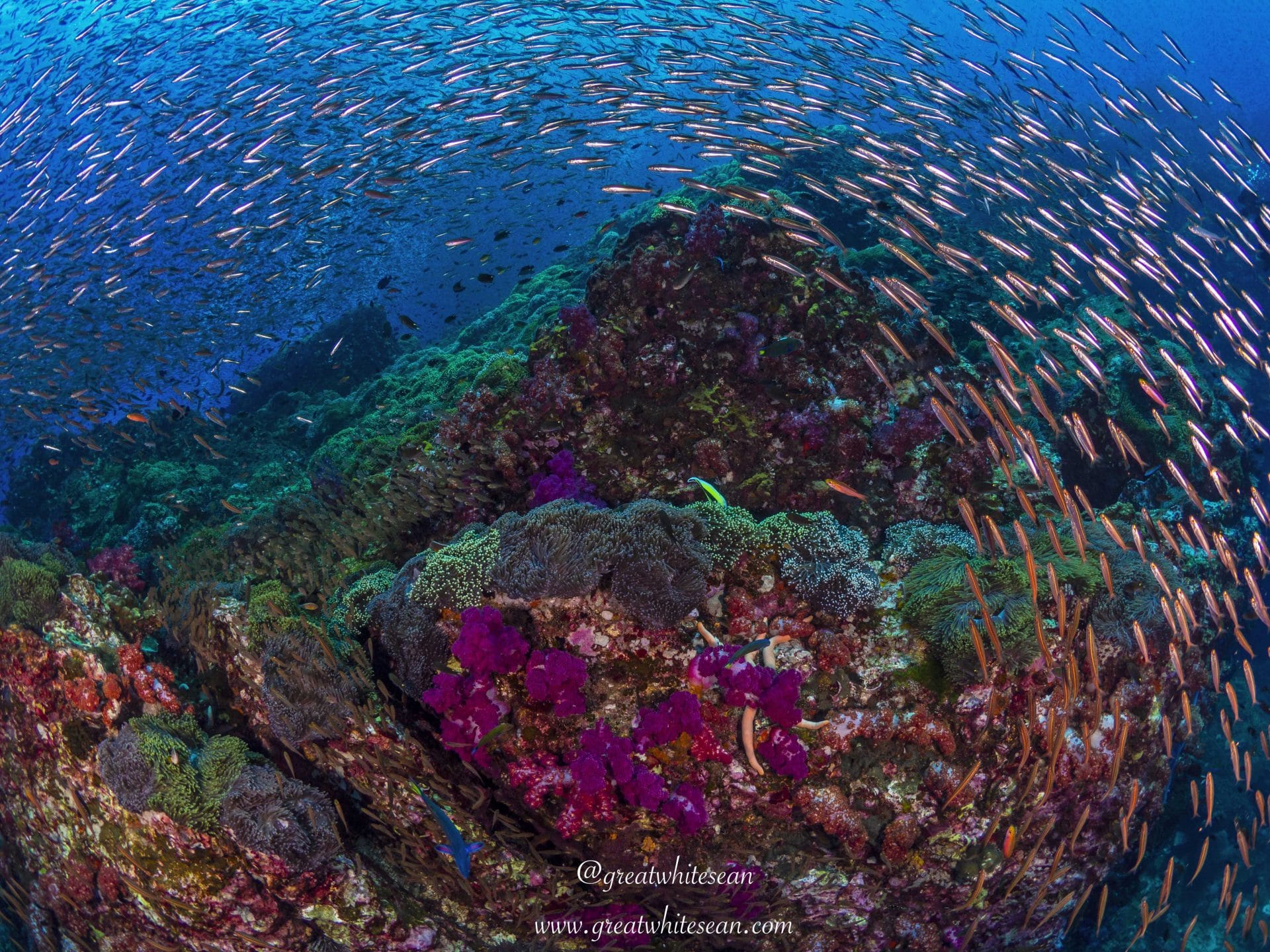
It was unfortunately time to head back to shore but on the morning of day four there was the opportunity for a couple of last dives before the trip ended. The dive site was BoonSoong Wreck, only an hour and a half from the marina. Unfortunately for my group we were all flying back at midnight that same night and after careful consideration decided after a hectic schedule of diving we would reluctantly miss this dive.
We heard from the others who dived it that the visibility wasn’t great at all but it is a great site to see honeycomb moray eels and one was spotted hunting along the wreck. Different species of nudibranch are also common here and the talk was of finding some along the way. A shame we couldn’t add the extra dive but the swarms of jellyfish at the surface kept me entertained as I gazed across the ocean.
I must admit I was at first left a little underwhelmed by the diving here and it was saved by the stunning Richelieu Rock site. However, on reflection, I feel that was my own fault in building up my expectations too much and telling myself I was going to see a whale shark, a manta, a zebra (leopard) shark and guitarfish. This was very naive of me considering the experiences I’ve already had diving around the world. This is nature and in most circumstances we can’t guarantee what’s going to happen, and that is what’s great about diving and keeps bringing us back underwater, the anticipation of what we may find.
I know that all these big exotic marine animals can be found here as I’ve seen photos of them from people diving the Similan Islands itinerary. Some were even seen by other dive groups on our boat, such as a zebra shark and feeding eagle ray. However, I was only diving here for three days so I’d have to be incredibly lucky to get all of them. This is a destination where you travel knowing that you are going to be surrounded by stunning topside views and the diving is going to be great fun no matter what happens. You have a great chance of hitting the jackpot with some unusual sightings and its all in the mindset how you see it. I’d certainly recommend a trip here, you never know what you might find! A word of warning though, the currents can get a little interesting.
Sean’s trip was organised by The Scuba Place. For more information and to book call +44 (0)207 644 8252, email reservations@thescubaplace.co.uk or visit www.comedivewithus.co.uk.
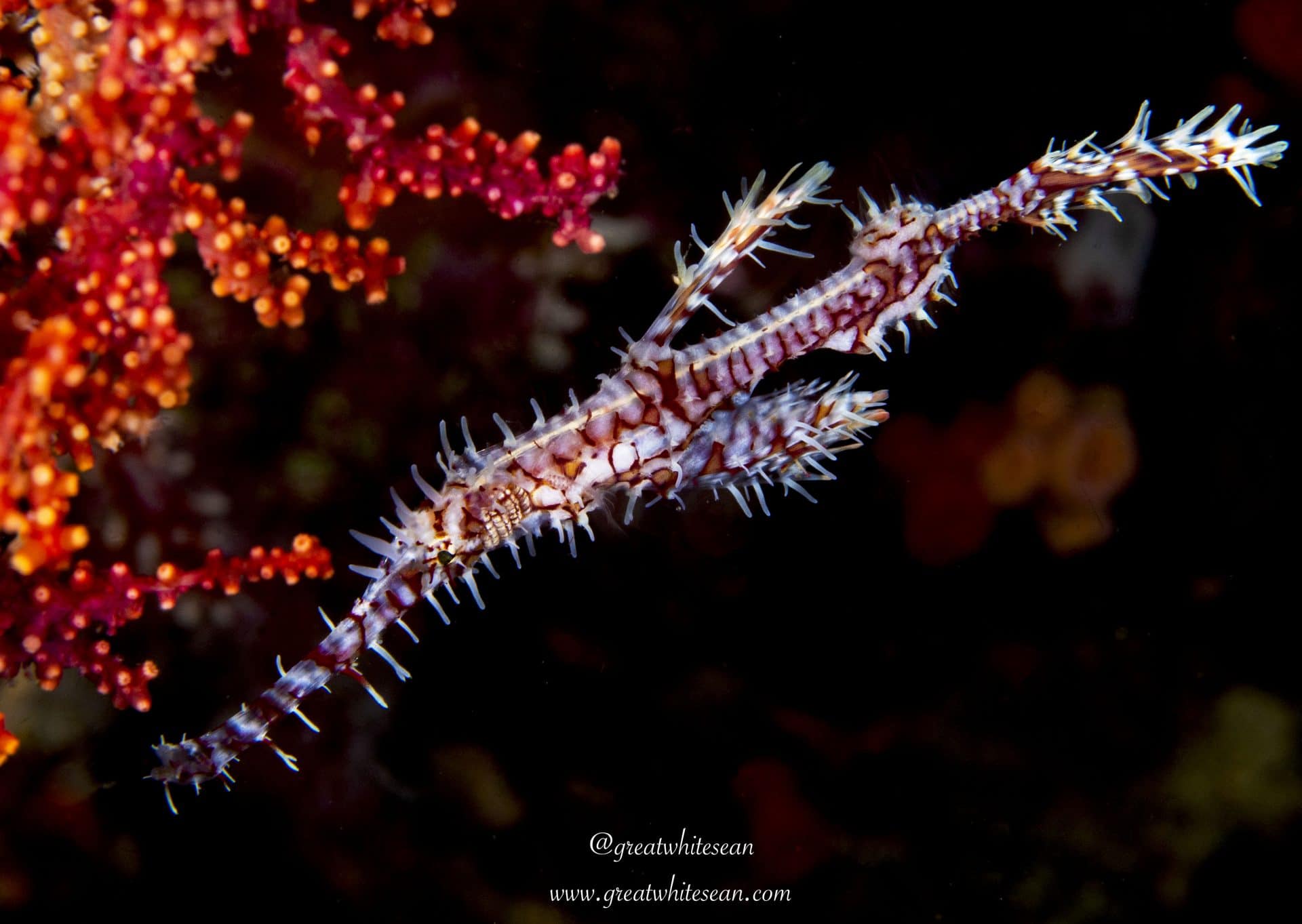
Blogs
Northern Red Sea Reefs and Wrecks Trip Report, Part 3: The Mighty Thistlegorm

Jake Davies boards Ghazala Explorer for an unforgettable Red Sea diving experience…
Overnight, the wind picked up, making the planned morning dive a bit bumpy on the Zodiacs to the drop point on Thomas Reef. There, we would dive along the reef before descending through the canyon and then passing under the arch before ascending the wall with a gentle drift. The site provided great encounters with more pelagic species, including shoals of large barracuda, tuna, and bigeye trevally.
Once back on the boat, it was time to get everything tied down again as we would head back south. This time, with the wind behind us, heading to Ras Mohammed to dive Jackfish Alley for another great gentle drift wall dive before then heading up the coast towards the Gulf of Suez to moor up at the wreck of the Thistlegorm. This being the highlight wreck dive of the trip and for many onboard, including myself, it was the first time diving this iconic wreck. I had heard so much about the wreck from friends, and globally, this is a must on any diver’s list. Fortunately for us, there was only one other boat at the site, which was a rarity. A great briefing was delivered by Ahmed, who provided a detailed background about the wreck’s history along with all the required safety information as the currents and visibility at the site can be variable.

Kitting up, there was a lot of excitement on deck before entering the water and heading down the shoreline. Descending to the wreck, there was a light northerly current which reduced the visibility, making it feel more like the conditions that can be found off the Welsh coast. At 10m from the bottom, the outline of the wreck appeared as we reached the area of the wreck which had been bombed, as our mooring line was attached to part of the propeller shaft. Arriving on deck, instantly everywhere you looked there were many of the supplies which the ship was carrying, including Bren Carrier tanks and projectiles that instantly stood out.

We headed around the exterior, taking a look at the large propeller and guns mounted on deck before entering the wreck on the port side to take a look in the holds. It was incredible to see all the trucks, Norton 16H, and BSA motorcycles still perfectly stacked within, providing a real snapshot in time.

Overall, we had four dives on the Thistlegorm, where for all of the dives we were the only group in the water, and at times, there were just three of us on the whole wreck, which made it even more special, especially knowing that most days the wreck has hundreds of divers. Along with the history of the wreck, there was plenty of marine life on the wreck and around, from big green turtles to batfish, along with shoals of mackerel being hunted by trevally. Some unforgettable dives.

The final leg of the trip saw us cross back over the Suez Canal to the Gobal Islands where we planned to stay the night and do three dives at the Dolphin House for the potential of sharing the dive with dolphins. The site, which included a channel that was teeming with reef fish, especially large numbers of goatfish that swam in large shoals along the edge of the reef. These were nice relaxing dives to end the week. Unfortunately, the dolphins didn’t show up, which was okay as like all marine life they are difficult to predict and you can’t guarantee what’s going to be seen. With the last dive complete, we headed back to port for the final night where it was time to clean all the kit and pack before the departure flight the next day.

The whole week from start to finish on Ghazala Explorer was amazing; the boat had all the facilities you need for a comfortable week aboard. The crew were always there to help throughout the day and the chefs providing top quality food which was required after every dive. The itinerary providing some of the best diving with a nice mixture of wreck and reef dives. I would recommend the trip to anyone, whether it’s your first Red Sea liveaboard in the Red Sea or you’re revisiting. Hopefully, it’s not too long before I head back to explore more of the Red Sea onboard Ghazala Explorer.

To find out more about the Northern Red Sea reef and wrecks itineraries aboard Ghazala Explorer, or to book, contact Scuba Travel now:
Email: dive@scubatravel.com
Tel: +44 (0)1483 411590
Photos: Jake Davies / Avalon.Red
Blogs
Northern Red Sea Reefs and Wrecks Trip Report, Part 2: Wall to Wall Wrecks

Jake Davies boards Ghazala Explorer for an unforgettable Red Sea diving experience…
The second day’s diving was a day full of wreck diving at Abu Nuhas, which included the Chrisoula K, Carnatic, and Ghiannis D. The first dive of the day was onto the Chrisoula K, also known as the wreck of tiles. The 98m vessel remains largely intact where she was loaded with tiles which can be seen throughout the hold. The stern sits at 26m and the bow just below the surface. One of the highlights of the wreck is heading inside and seeing the workroom where the machinery used for cutting the tiles are perfectly intact. The bow provided some relaxing scenery as the bright sunlight highlighted the colours of the soft coral reef and the many reef fish.

Following breakfast, we then headed to the next wreck, which was the Carnatic. The Carnatic is an 89.9m sail steamer vessel that was built in Britain back in 1862. She ran aground on the reef back in 1869 and remains at 27m. At the time, she was carrying a range of items, including 40,000 sterling in gold. An impressive wreck where much of the superstructure remains, and the two large masts lay on the seafloor. The wooden ribs of the hull provide structures for lots of soft corals, and into the stern section, the light beams through, bouncing off the large shoals of glass fish that can be found using the structure as shelter from the larger predators that are found outside of the wreck.

The final wreck at Abu Nuhas was the Ghiannis D, originally called ‘Shoyo Maru,’ which was 99.5m long and built in Japan back in 1969 before becoming a Greek-registered cargo ship in 1980. The ship then ran aground on the reef on April 19th, 1983, and now sits at the bottom at a depth of 27m. Heading down the line, the stern of the ship remains in good condition compared to the rest of the hull. The highlight of the wreck, though, is heading into the stern section and down the flights of stairs to enter the engine room, which remains in good condition and is definitely worth exploring. After exploring the interior section of the ship, we then headed over to see the rest of the superstructure, where it’s particularly interesting to see the large table corals that have grown at the bow relatively quickly considering the date the ship sank. After surfacing and enjoying some afternoon snacks, we made sure everything was strapped down and secured as we would be heading north and crossing the Gulf of Suez, where the winds were still creating plenty of chop.

The next morning, it was a short hop to Ras Mohammed Nature Reserve for the next couple of days of diving. The 6am wake-up call came along with the briefing for the first site we would be diving, which was Shark & Yolanda. The low current conditions allowed us to start the dive at Anemone City, where we would drift along the steep, coral-filled wall. These dives involved drifts, as mooring in Ras Mohammed wasn’t allowed to protect the reefs. As a dive site, Shark & Yolanda is well-known and historically had a lot of sharks, but unfortunately not so many in recent years, especially not so early in the season. However, there was always a chance when looking out into the blue.

The gentle drift took us along the steep walls of the site, with plenty of anemone fish to be seen and a huge variety of corals. It wasn’t long into the dive before we were accompanied by a hawksbill turtle, who drifted with us between the two atolls before parting ways. Between the two reefs, the shallow patch with parts of coral heads surrounded by sand provided the chance to see a few blue-spotted stingrays that were mainly resting underneath the corals and are always a pleasure to see. With this being the morning dive, the early sunlight lit up the walls, providing tranquil moments. Looking out into the blue, there was very little to be seen, but a small shoal of batfish shimmering underneath the sunlight was a moment to capture as we watched them swim by as they watched us.

Towards the end of the dive, we stopped at the wreck of the Jolanda where the seafloor was scattered with toilets from the containers it was carrying. This provided a unique site to make a safety stop, which was also accompanied by a large barracuda slowly swimming by, along with a hawksbill turtle calmly swimming over the reef as the sun rays danced in the distance.
For the next dive, we headed north to the Strait of Tiran to explore the reefs situated between Tiran Island and Sharm El Sheik, which were named after the British divers who had found them. We started on Jackson before heading to Gordons Reef, where we also did the night dive. All the atolls at these sites provided stunning, bustling coral reefs close to the surface and steep walls to swim along, which always provided the opportunity to keep an eye out for some of the larger species that can be seen in the blue. Midwater around Jackson Reef was filled with red-toothed triggerfish and shoals of banner fish, which at times were so dense that you couldn’t see into the blue. Moments went by peacefully as we enjoyed the slow drift above the reef, watching these shoals swim around under the mid-afternoon sun.

The night dive at Gordon’s Reef was mainly among the stacks of corals surrounded by sand, which was great to explore under the darkness. After some time circling the corals, we came across what we were really hoping to find, and that was an octopus hunting on the reef. We spent the majority of the dive just watching it crawl among the reef, blending into its changing surroundings through changes in colour and skin texture. It’s always so fascinating and captivating to watch these incredibly intelligent animals, in awe of their ability to carry out these physical changes to perfectly blend into the reef. Before we knew it, it was time to head back to the boat to enjoy a well-deserved tasty dinner prepared by the talented chefs onboard.
Check in for the 3rd and final part of this series from Jake tomorrow!
To find out more about the Northern Red Sea reef and wrecks itineraries aboard Ghazala Explorer, or to book, contact Scuba Travel now:
Email: dive@scubatravel.com
Tel: +44 (0)1483 411590
Photos: Jake Davies / Avalon.Red
-

 News3 months ago
News3 months agoHone your underwater photography skills with Alphamarine Photography at Red Sea Diving Safari in March
-

 News3 months ago
News3 months agoCapturing Critters in Lembeh Underwater Photography Workshop 2024: Event Roundup
-

 Marine Life & Conservation Blogs2 months ago
Marine Life & Conservation Blogs2 months agoCreature Feature: Swell Sharks
-

 Blogs2 months ago
Blogs2 months agoMurex Resorts: Passport to Paradise!
-

 Blogs2 months ago
Blogs2 months agoDiver Discovering Whale Skeletons Beneath Ice Judged World’s Best Underwater Photograph
-

 Gear Reviews3 months ago
Gear Reviews3 months agoGear Review: Oceanic+ Dive Housing for iPhone
-

 Marine Life & Conservation2 months ago
Marine Life & Conservation2 months agoSave the Manatee Club launches brand new webcams at Silver Springs State Park, Florida
-

 News3 months ago
News3 months agoWorld’s Best Underwater Photographers Unveil Breathtaking Images at World Shootout 2023
















